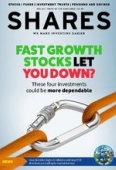Archived article
Please note that tax, investment, pension and ISA rules can change and the information and any views contained in this article may now be inaccurate.
Why every investor should make sure they own a diversified portfolio

It might sound odd, but diversification isn’t designed to maximise your returns, so you may well ask what is the point?
Diversification is ‘the practice of spreading your investments so that your exposure to any one type of asset is limited’, according to US fund giant Fidelity.
The idea is that holding a selection of different investments should help reduce the volatility of your portfolio over time.
The same applies if you just have a portfolio of stocks – you need to spread your bets so that you aren’t putting all your eggs in one basket.
WAYS TO DIVERSIFY
If you mainly invest in shares and don’t want to hold bonds, commodities, real estate or other assets directly, it is still possible to get exposure to these asset classes indirectly by buying shares or units in an investment trust, fund or ETF (exchange-traded fund).
Also, if you like a sector but you would rather not take individual stock risk, you can invest in sector-specific investment trusts, funds and ETFs.
The same goes for investment themes like ESG investing, robotics, space technology or biotechnology, for instance.
Buying a fund or a trust takes the guesswork out of the equation as the managers, who are typically specialists in their field, do the work for you. An ETF also makes life easier by tracking an index of relevant shares, so you don’t have to do any stock picking.
TIME AND RISK
There are two things you need to consider when building a portfolio: how long you need to invest for and how much risk you are prepared to take to reach your goals.
If you have a 30-year time horizon then you will probably be more willing to take risks as you have time to make up for any poor decisions, although it’s worth repeating the first rule of generating wealth – don’t lose money.
If you have a relatively short time horizon then you probably won’t want to take too many risks as you don’t want to lose capital.
Whatever your perspective, however, you should only take on the level of risk you are comfortable with, and diversification is a way to moderate risk.
HOW MUCH IS TOO MUCH?
One of the earliest studies into the benefits – and the limitations – of diversification was by academics John Evans and Stephen Archer of the University of Washington in 1968.
In their paper Diversification and the Reduction of Dispersion: An Empirical Analysis, the authors concluded the optimal size for a portfolio was between 10 and 15 stocks.
Beyond that, once the number of stocks topped 20 the benefits of diversification tailed off dramatically.
There has been a lot of academic research since the Evans and Archer paper was published, with most concluding that somewhere between 15 and 40 stocks works best.
In The Behavioural Investor, Daniel Crosby cites a Morningstar study which measured the volatility of high-conviction portfolios – those with less than 40 stocks – against the volatility of much broader portfolios with more than 200 holdings.
The study concluded that ‘concentrated funds are not more volatile than more diversified funds on average and some are surprisingly steady despite their small number of holdings’.
THE COST OF NOT DIVERSIFYING
A study in the Review of Finance by William Goetzmann and Alok Kumar concluded that, in general, US individual investors were guilty of owning ‘under-diversified’ portfolios.
They found the level of under-diversification was greater among younger, low-income, less educated and less sophisticated investors.
The authors said: ‘The level of under-diversification is also correlated with investment choices that are consistent with over-confidence, trend-following behaviour, and local bias.’
If that sounds like the recent craze for meme investing where young, bored, first-time investors started spending their stimulus cheques on whatever was hot on Reddit chat boards or social media platforms, it’s no coincidence.
Another key aspect of the study was finding clear economic costs to being under-diversified in terms of performance.
‘As the level of diversification increases, both performance measures (mean monthly excess return and the Sharpe ratio) increase,’ report the authors.
On an annual basis, the most diversified investor group earned a 2% higher return than the least diversified group which in theory is taking more risk.
Part of the reason was that more diversified investors trade less frequently, because they have a greater range of investments, while part of the performance gap was down to the ‘large idiosyncratic risk exposures’ of the less diversified.
In other words, less diversified investors tend to go for stocks they think will go to the moon and tend to go all-in rather than doing their research and spreading their bets.
What do famous investors have to say about diversification?
Benjamin Graham, author of The Intelligent Investor, believed it was enough to own between 10 and 30 holdings of ‘large, prominent, conservatively financed companies` with a bias towards those with low debt to equity ratios and high yields.
Warren Buffett argued instead you should own between five and 10 stocks ‘if you are a “know-something” investor, able to understand business economics and to find sensibly-priced companies which possess important long-term competitive advantages.’
John Maynard Keynes, who is often considered to be the father of modern economic theory, believed a dozen or so companies ‘which one thinks one knows something about, and in the management of which one thoroughly believes’, was the optimal size for a portfolio.
Seth Klarman, billionaire investor and founder of Baupost, also argues in favour of around a dozen stocks because you are ‘better off knowing a lot about a few investments than knowing just a little about each of a great many holdings.’
Ultimately, common sense suggests you are better off holding a smaller number of stocks than a larger number as long as you are really doing your homework on them.
Important information:
These articles are provided by Shares magazine which is published by AJ Bell Media, a part of AJ Bell. Shares is not written by AJ Bell.
Shares is provided for your general information and use and is not a personal recommendation to invest. It is not intended to be relied upon by you in making or not making any investment decisions. The investments referred to in these articles will not be suitable for all investors. If in doubt please seek appropriate independent financial advice.
Investors acting on the information in these articles do so at their own risk and AJ Bell Media and its staff do not accept liability for losses suffered by investors as a result of their investment decisions.
Issue contents
Education
Funds
Great Ideas
- Fulham Shore is navigating cost pressures well and continues to expand
- Buy shares in Photo-Me for its underappreciated earnings potential
- Watches of Switzerland's shares have fallen too far, buy them now
- Don't worry about slowing orders at Chemring as it looks well placed
- Cheniere Energy outperforms the global stock market
- Still plenty of reasons to want to invest in this property expert
News
- Apple’s push into advertising poses challenges for Meta, Alphabet and Snap
- Airline shares dive amid prospect of high compensation costs
- Why shares in Primark parent Associated British Foods are languishing near five-year lows
- How decades high US inflation and new ECB direction are leading to market turmoil

 magazine
magazine








